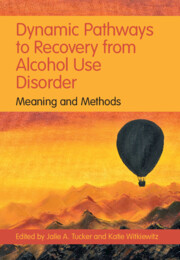Book contents
- Dynamic Pathways to Recovery from Alcohol Use Disorder
- Dynamic Pathways to Recovery from Alcohol Use Disorder
- Copyright page
- Dedication
- Contents
- Figures
- Tables
- Contributors
- Foreword
- Preface
- Acknowledgments
- Introduction
- Part I Micro Level
- 2 Biopsychosocial Process of Change in Alcohol Use Disorder Recovery
- 3 The Role of Self-Regulation Strategies in Recovery from Alcohol Use Disorder
- 4 Neuropsychological and Biological Influences on Drinking Behavior Change
- 5 Lifespan Developmental Perspectives on Natural Mechanisms of Cessation of Risky Alcohol Use and Recovery from Alcohol Use Disorder
- 6 Mutual Help Approaches and Mechanisms of Change
- 7 Time-Varying Effect Modeling to Examine Recovery Outcomes across Four Years
- 8 Latent Variable Mixture Modeling Approaches to Investigating Longitudinal Recovery Processes
- Part II Meso Level
- Part III Macro Level
- Conclusions and Future Directions
- Index
- References
5 - Lifespan Developmental Perspectives on Natural Mechanisms of Cessation of Risky Alcohol Use and Recovery from Alcohol Use Disorder
from Part I - Micro Level
Published online by Cambridge University Press: 23 December 2021
- Dynamic Pathways to Recovery from Alcohol Use Disorder
- Dynamic Pathways to Recovery from Alcohol Use Disorder
- Copyright page
- Dedication
- Contents
- Figures
- Tables
- Contributors
- Foreword
- Preface
- Acknowledgments
- Introduction
- Part I Micro Level
- 2 Biopsychosocial Process of Change in Alcohol Use Disorder Recovery
- 3 The Role of Self-Regulation Strategies in Recovery from Alcohol Use Disorder
- 4 Neuropsychological and Biological Influences on Drinking Behavior Change
- 5 Lifespan Developmental Perspectives on Natural Mechanisms of Cessation of Risky Alcohol Use and Recovery from Alcohol Use Disorder
- 6 Mutual Help Approaches and Mechanisms of Change
- 7 Time-Varying Effect Modeling to Examine Recovery Outcomes across Four Years
- 8 Latent Variable Mixture Modeling Approaches to Investigating Longitudinal Recovery Processes
- Part II Meso Level
- Part III Macro Level
- Conclusions and Future Directions
- Index
- References
Summary
This chapter reviews lifespan developmental perspectives on cessation of risky alcohol use and recovery from alcohol use disorder (AUD). The chapter discusses AUD assessment with an emphasis on lifespan developmental issues; the epidemiology of risky alcohol use with an emphasis on age differences; and influences on risky use, AUD, and recovery in different periods of the lifespan. Adolescent risky drinking can be understood as developing through three etiologic-risk pathways. Risky drinking is especially normative at 18-23 years old and thus especially likely to reflect a temporary, context-driven “developmental disturbance,” which has implications for subsequent recovery. Drinking-related rates decline in young adulthood, and apparent mechanisms of this “maturing out” are discussed (e.g., personality maturation, marriage, parenthood). Regarding midlife and older adulthood, the limited extant literature is reviewed and indicates the need for more lifespan developmental research attending to these ages and examining differences in how recovery occurs across the lifespan.
Keywords
- Type
- Chapter
- Information
- Dynamic Pathways to Recovery from Alcohol Use DisorderMeaning and Methods, pp. 77 - 94Publisher: Cambridge University PressPrint publication year: 2022
References
- 1
- Cited by



